For my second omakase experience during this trip to the San Francisco Bay Area, I went to Utzutzu on Park Street in Alameda, California.
After a bit of an underwhelming experience at Delage the night prior, I was hoping that Utzutzu would be different and meet or exceed my expectations.
After doing a bit of research, I noticed some information online that implied Delage and Utzutzu may be related in some way, but that information was a handful of years old. Considering how quickly restaurants can change (especially during the COVID-19 pandemic from the past few years), I think that the two spots may have split and underwent new management—Utzutzu had a completely different feel to it than Delage, and Utzutzu resembled a true, traditional Japanese omakase experience.
The entrance to Utzutzu is inconspicuous, and I wouldn’t have been able to find it if I didn’t keep an eye out for building numbers—it is up the stairs and around the corner above a consignment shop called Mommy’s Trading Post. The restaurant is fairly small, with a little waiting area near the entrance and a seven-seat bar for diners who can watch the chef prepare their meals while they enjoy their food.
The first course of the night was a pair of appetizers—kinpira gobo and black goma asparagus. Kinpira gobo is a traditional Japanese dish made from braised burdock root and carrots sprinkled with sesame seeds; the asparagus dish was cooked and seasoned with black sesame paste.
Both appetizers were great—they had the perfect amount of zest to get your taste buds going, but was still subtle enough that it allowed the deep, rich flavors of the vegetables to shine through.
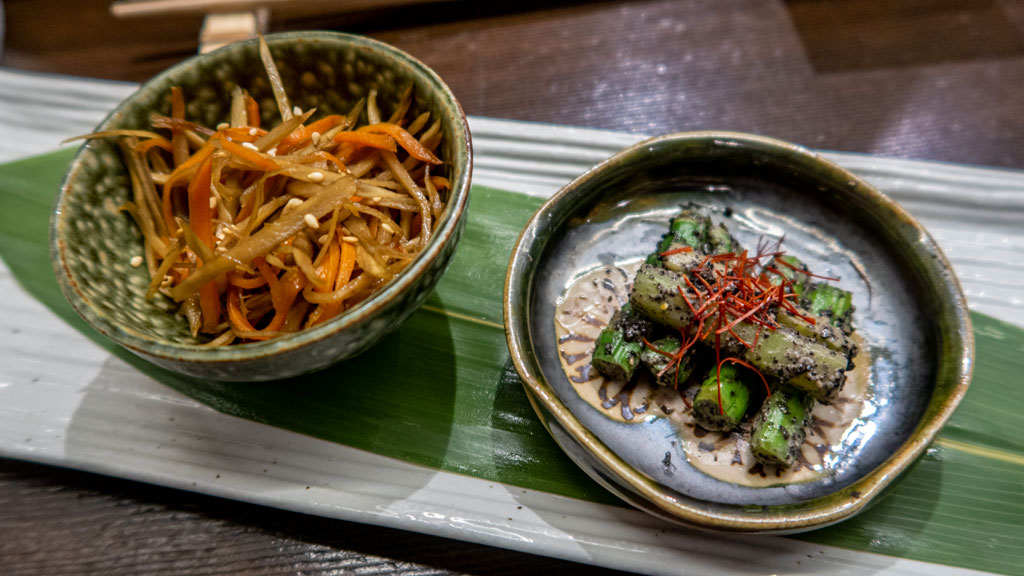
The second dish was nanbanzuke. This one was made with Scottish sea trout that had been sitting for eight hours inside the vinaigrette with a medley of vegetables so it can fully absorb the flavors. The trout had maintained its structure throughout the soaking process and was firm on the outside, but fell apart in my mouth and was extremely tender when I started chewing.
Similar to the appetizers, this dish also had a nice, sharp flavor to it that gently tingled my tongue, but it wasn’t uncomfortably sour. I noticed that this was a recurring theme throughout this particular omakase experience—this chef did an amazing job properly diluting sauces so that there was no single taste (sourness, saltiness, sweetness, etc.) that overwhelmed the true, underlying flavor of the ingredients.
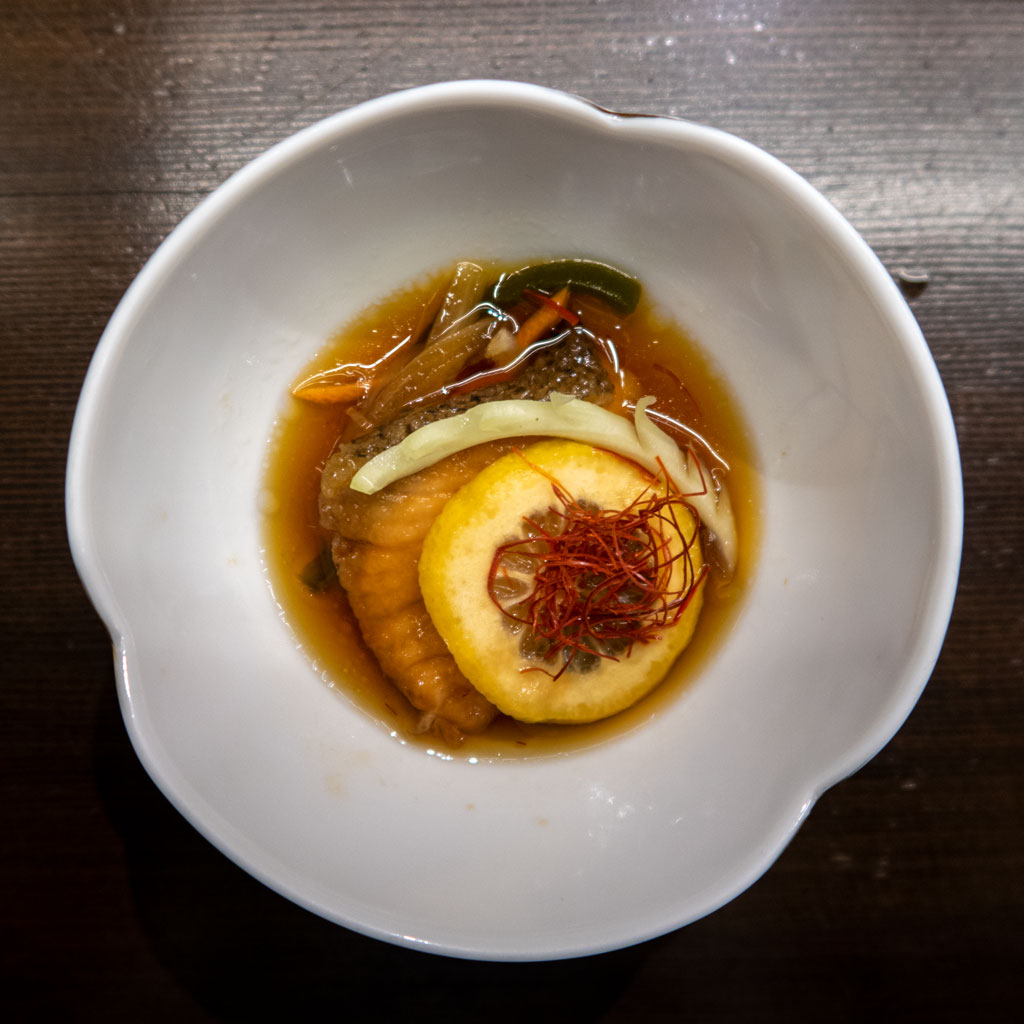
A big part of omakase is being able to have an interactive experience with your chef and watch your next course being prepared. Utzutzu’s layout made this very easy—each diner was within about two meters of the chef throughout the whole meal, only separated by a thin, clear cough guard at face level. The chef personally hand-delivered each piece of nigiri through an opening at the bottom of the panel.
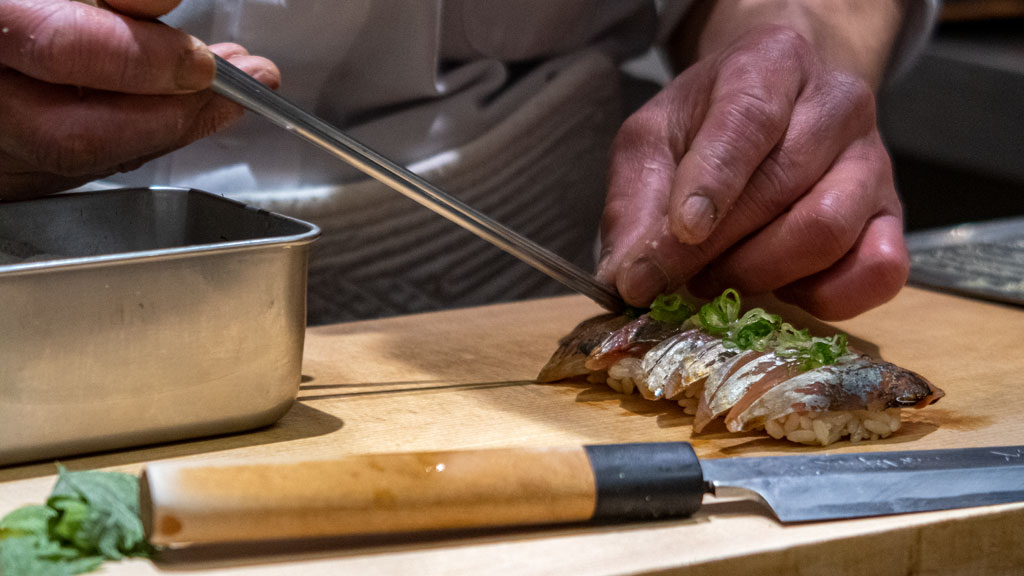
The first sequence of nigiri had nine pieces, and all of them were great. The size of each cut of fish wasn’t generous, but it was still a very satisfying amount. The ratio of rice to fish was excellent, and it also seemed like the chef might have been actively changing the portion size of rice, depending on the intensity of the fish, in order to properly complement the flavor.
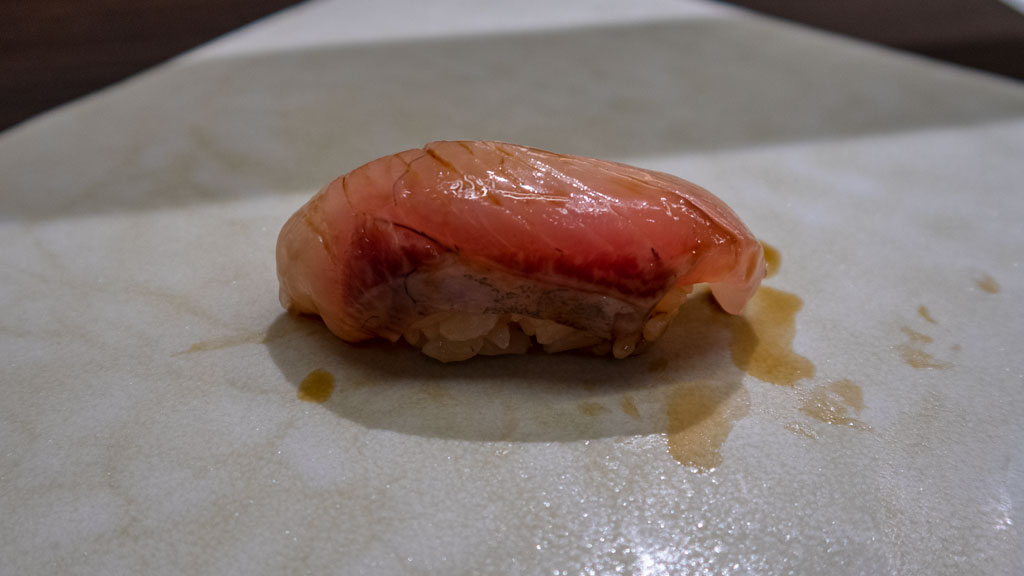
Along with our omakase experience from the chef, we also had the convenience of having a comedy show on the side. My friend and I took up two seats, and we had two other parties as our dining companions who had booked the same reservation slot: one group of three elderly friends, and one group of a young couple celebrating their anniversary.
I personally didn’t notice this because I was too focused on capturing photos, enjoying the food, and taking notes, but my friend told me that the elderly diners were subtly making fun of me for how I seemed to be taking everything so seriously. From that, plus their very casual attire, I imagine they weren’t the most familiar with fine dining (which, to be clear, I have no problem with; I think it’s heartwarming when the elderly go out to sophisticated experiences that they might not have been able to enjoy when they were younger). I did have a brief interaction with them near the end of the meal, which I’ll cover later, and they were all very pleasant people.
The actual funny part, though, was the younger couple. The man seemed to love sushi, but the woman notified the chef that she doesn’t eat snapper and mackerel because they taste too fishy (which, to be clear, snapper does not have a strong fishy taste, and in fact, it is often recommended for sushi beginners due to its milder flavor).
The solution here would have been to not go to omakase, considering that this completely defeats the purpose of omakase (which, translated from Japanese, means “I’ll leave it up to you”), but of course, the chef wanted to be respectful of her wishes and tried to accommodate. Not only did we have red snapper, but we also had two types of mackerel—regular mackerel (Scombridae) and horse mackerel (Carangidae)—so he ended up substituting them with more basic options, like tuna and salmon roe. More on this later.
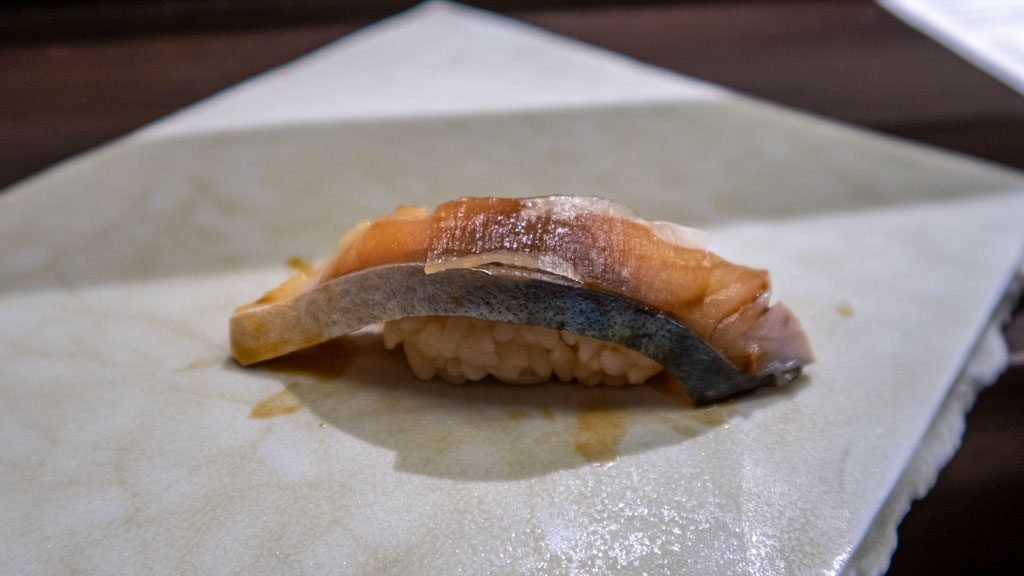
The final piece of nigiri in this half of the meal was this mysterious orange fish. Based on its taste, I am 99% sure it is salmon, but my friend insists the chef had called it some complicated name that she had never heard of before.
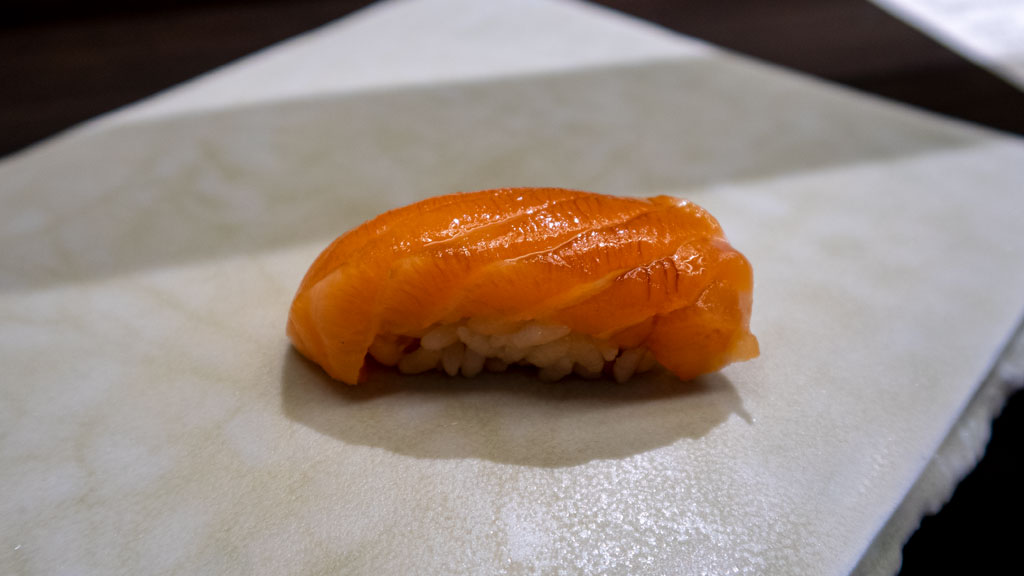
The following course was sumiso-ae with octopus and cucumber. Again, this had the same theme as the previous dishes prior to the chain of nigiri—the sauce was tangy and noticeable, but was still smooth and complementary enough to the rest of the ingredients that it felt like I was eating well-seasoned raw octopus (as opposed to just a sour salad).

Next was chawanmushi, or Japanese steamed egg custard. The inside contained mushrooms and a gingko nut, and the outside was topped with a piece of sea urchin. Contrary to what you’d expect from custard, this Japanese steamed variant was not sweet at all. Instead, this entire dish was a constant flow of different kinds of umami coming from all four main ingredients.
The quality of the uni was also fantastic—it had a strong and prominent uni flavor that wasn’t diluted or faded, and it had the amazing, soft, buttery texture that you expect when rolling it around on your tongue and then pressing it up against the roof of your mouth.
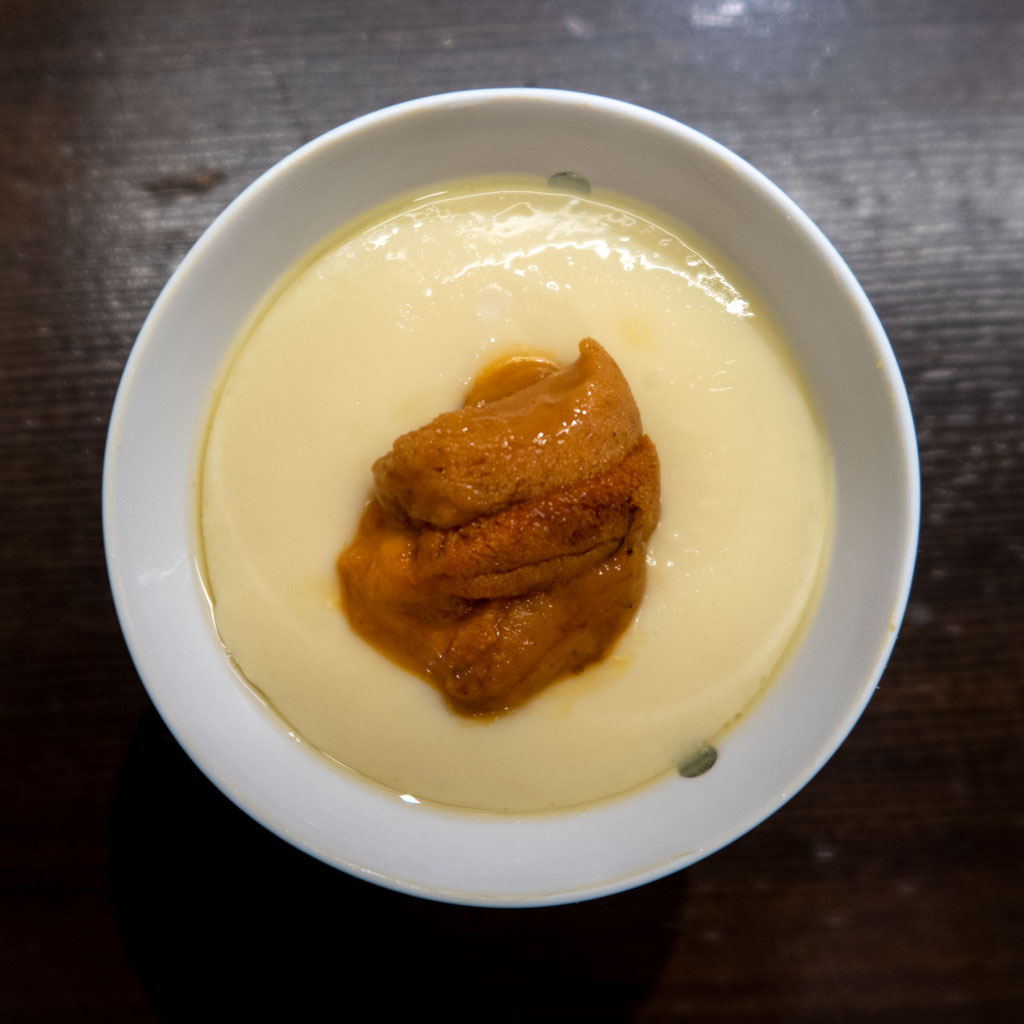
After the brief intermission, we returned to nigiri for a second round. This next batch was a bit more untraditional; the nigiri from the first half covered different kinds fish that you’d probably expect from a sushi restaurant, while the second half allowed the chef to mix in a few more creative pieces.
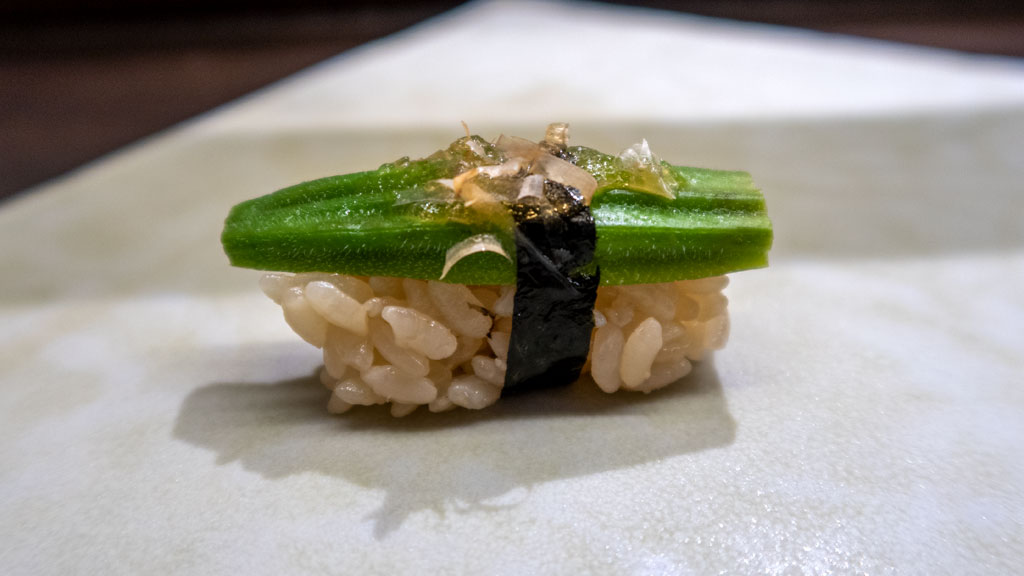
One of the pieces I particularly liked was the scallop. Usually, I’ve seen scallop sushi served as nigiri in a more circular shape (considering that is the original shape of the scallop), or diced and placed on top of rice inside a circular gunkan maki roll wrapped by seaweed. Instead, this chef cut the scallop in half horizontally about 80% of the way through, allowing it to open up and rest on top of the pillow of sushi rice like a little tent.
He seared the top of the scallop with a flame, giving it an ever-so-tiny tinge of charred bitterness. However, it was so subtle that it didn’t actually fully register in my mouth as bitterness, and simply enhanced the cooked taste of the scallop with a new flavor dimension.
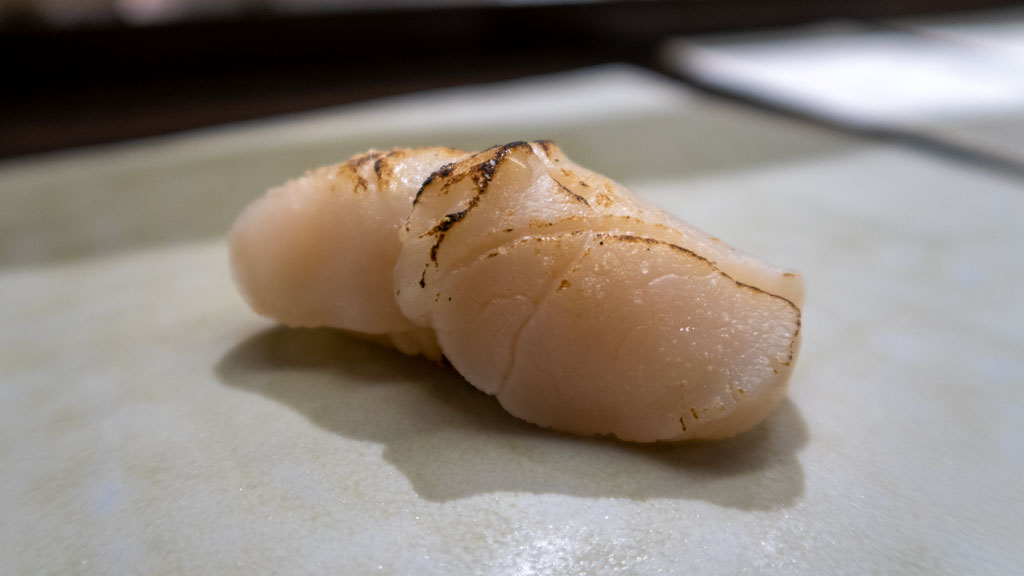
This second round of nigiri was the chef’s opportunity to have us try some non-fish options as well. As you can see from above, one of the pieces was okra with bonito flakes. He also served us some wagyu beef.
He crafted the pieces of wagyu in front of us directly out of a cut of steak, and we were able to see the stunning marbling, iconic of high-grade wagyu. After preparing a piece for each person, he lined them up and seared the outside with the same flame he had just used for the scallops a few moments prior. This added a perfect sear to the outside and rendered just enough fat that it brought the beef to the melt-in-your-mouth status you expect from wagyu.
Garnished lightly with some subtle sauce and topped with a few circular cuts of scallion, the wagyu nigiri was a pleasant flavorful change-up from the fish and seafood that made up a majority of the line-up.

People say that one of the best ways to determine the skill of a sushi chef is to try their tamago, or Japanese rolled omelet. I believe the rationale behind this is that cooking a basic egg dish like this tests whether the chef has strong fundamentals and a solid foundation upon which they can base the rest of their cooking (as opposed to having to rely solely on gimmicks). I’ve heard similar things said by Western chefs with regards to scrambled eggs.
Without exaggeration, this was the best tamago I have ever had. It ascended to a level where I’m not really even sure how to describe it. It tasted like amazing tamago, but with some extra magic sprinkled in on top of that.
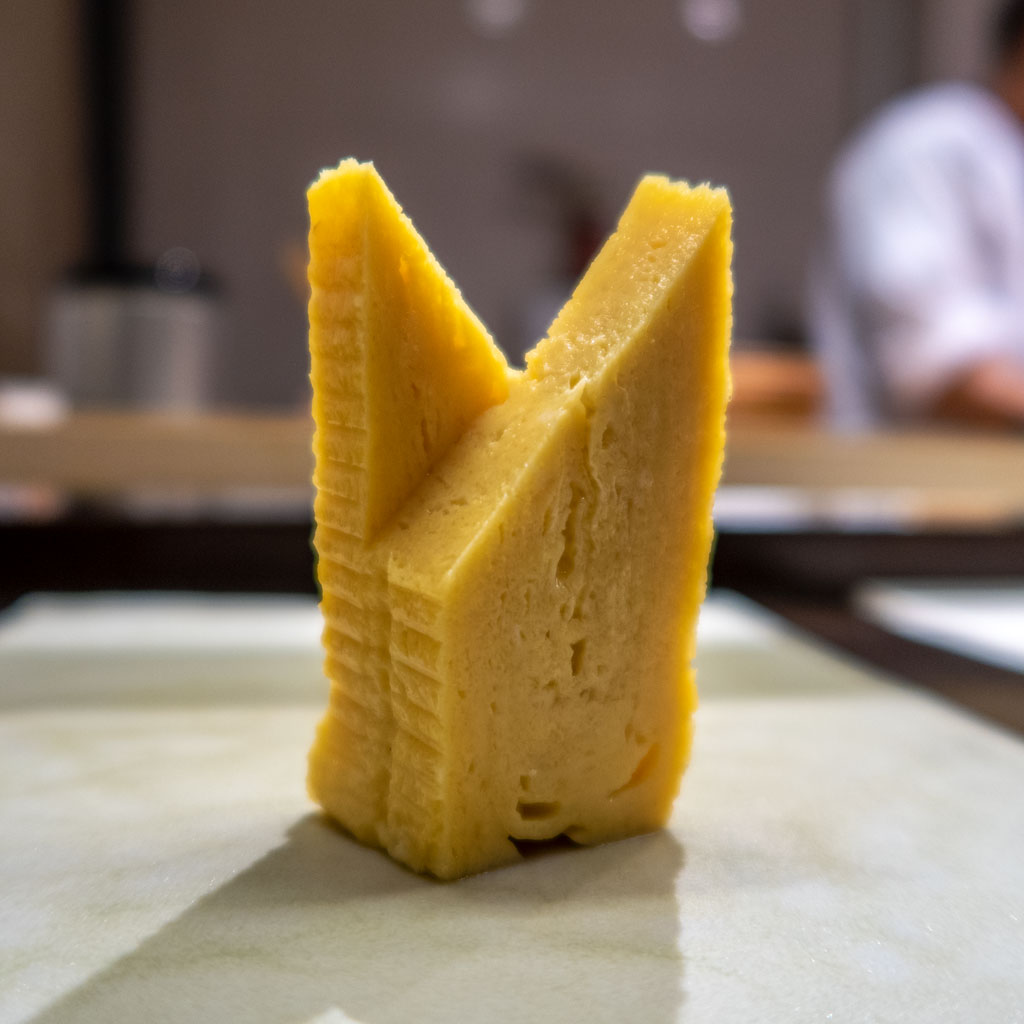
After the chef finished serving us six pieces as part of the second round of nigiri, he asked us whether we had any special requests. By the way that it was communicated to us, I was under the impression that this special request would be the final item of the second chain of nigiri. My friend and I both like sea urchin, so we requested for the chef to craft something for us made from sea urchin.
The chef made each of us a special piece of uni gunkan maki loaded with sea urchin and carefully held together with seaweed. The tension of the seaweed was so perfect that, upon placing the maki in my mouth and biting down, the wrap burst and created a single, big popping sensation that made it feel as if I was eating a humongous piece of roe with uni inside. The uni was somehow even better than the uni in the chawanmushi from earlier, though that is most likely because I just really like uni and that was the singular dominating flavor of the gunkan maki.
After getting the bill later, I discovered that this was not in fact the final piece of the second round of nigiri, but rather, an add-on service for US$18.00 each. That wasn’t that huge of a deal, though; that is pretty pricey for one piece of sushi, but the quantity of sea urchin in each gunkan maki was satisfying, and the market price for sea urchin of that quality can climb pretty high. All things considered, it wasn’t an unreasonable price for the value we received.
But… remember the couple I mentioned earlier who had the anti-mackerel woman? Well, sometime during her meal, she changed her mind and decided that she wanted to try the mackerel nigiri. When it came up during the regular rotation, she had gotten a slice of standard akami tuna instead as a substitution. Now that she had an opportunity to request something specific, she requested mackerel.
She didn’t spit it out or anything so I guess it was fine, but the hilarity here is that, if you think about it, she technically used a special request for akami tuna, probably one of the most simple, basic, and inexpensive sushi options (considering that the mackerel she just ate was the equivalent of the regular nigiri course, so the “extra” piece she got was tuna).
If my receipt said “sea urchin” or “uni,” it would be clear that the special requests are charged specific to what you order, but the receipt simply said “nigiri add-on,” which implies that it is just a flat fee for the add-on service. I almost felt bad for her for paying US$18 for a piece of tuna nigiri, but then I remembered that she came to omakase, the entire point of which is to allow the chef to tell you a story through food, and interfered with him… so instead, I took her clown show as a nice form of entertainment while I had my meal.
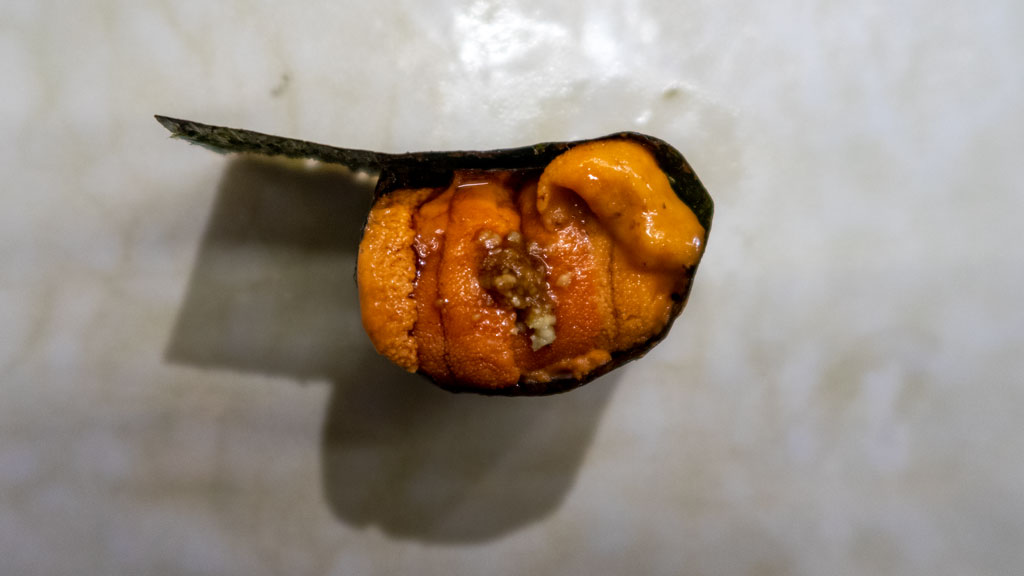
As the experience came to an end, we were served some akadashi. The waiter let us know that the soup was boiled with the heads and bones of all the fish that we had eaten to extract their flavor, as a way to try and minimize waste and get the most value out of as much of the fish as possible.
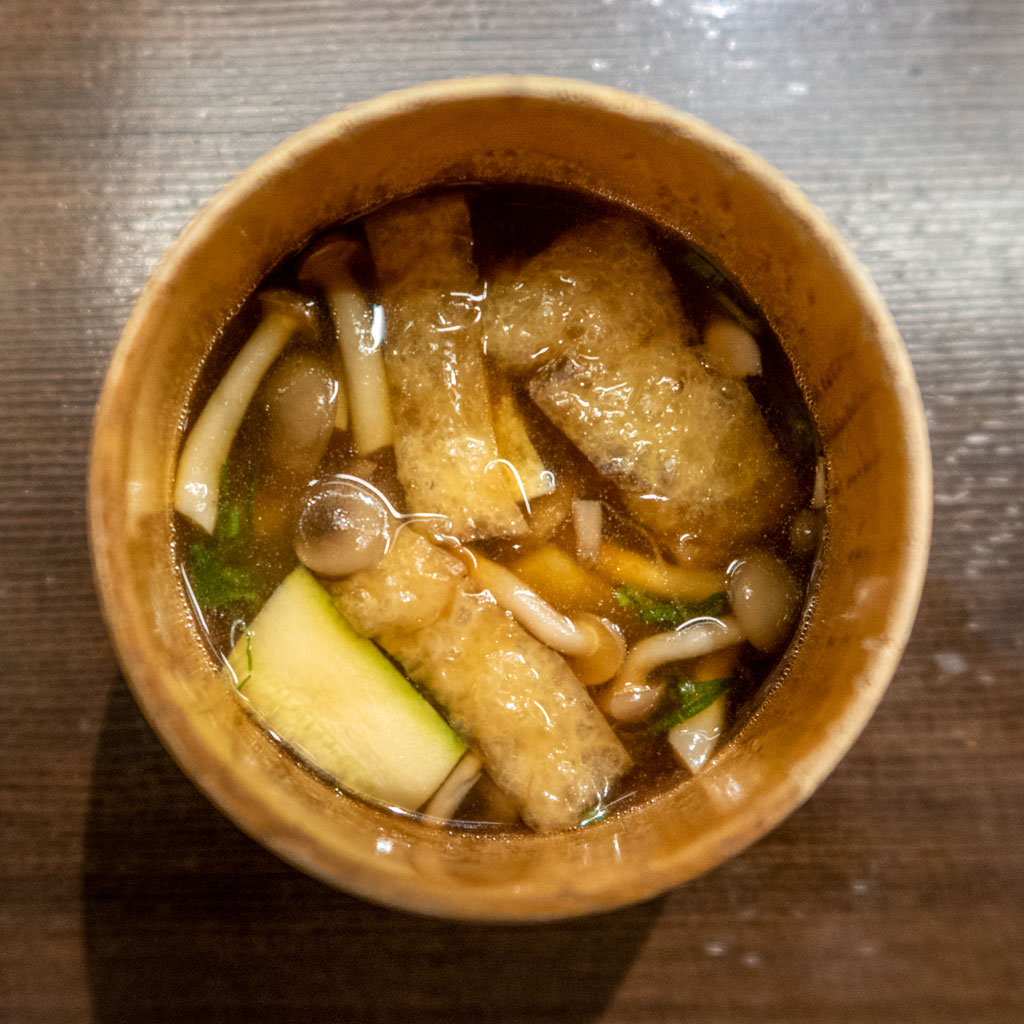
For dessert, we were served mango shiso sorbet. The friend who joined me for this dinner had celebrated a birthday the week prior, so we figured it wouldn’t hurt to mark on the reservation that we were there for a birthday, just in case they would do something special for her. We didn’t get any free cake or an occasion discount anything, but they did stick a candle in her sorbet and gave her a little sign that read “Happy Birthday.”
Our reservation companions—namely, one of the elderly men from the group of three—noticed the candle and began singing the Happy Birthday song to her, with everyone else joining in shortly afterwards. She blew out the candle and it made for a nice conclusion to the dinner.
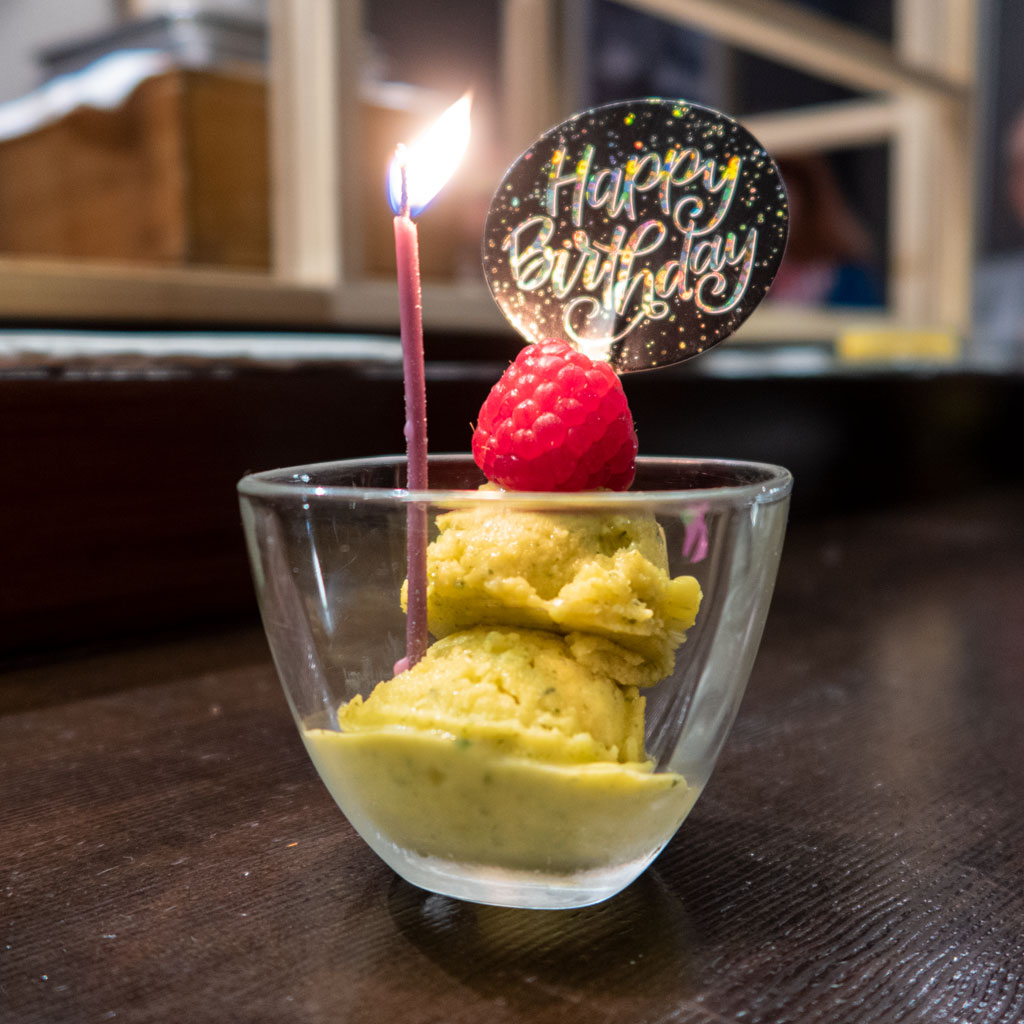
Here is a breakdown of what we paid:
| Omakase ×2 | $ 290.00 |
| Special request nigiri add-on ×2 | $ 36.00 |
| Tax (10.75%) | $ 35.06 |
| Gratuity | $ 50.00 |
| Total | $ 411.06 |
This obviously is not a small amount of money, especially considering the extra add-on service, and it was more expensive than the omakase at Delage, but I still think this was very worth it, and I’m very glad that I went.
Sometimes, great chefs will begin raising their omakase prices higher and higher, and after a few hundred dollars per person, the price sort of becomes arbitrary. In other words, you aren’t going to notice that huge of a quality difference between a $300-per-person meal and a $400-per-person meal, and at that point, the pricing is generally determined more by how much the restaurant can get away with charging while still keeping their reservation slots full.
With that being said, Utzutzu is not like that, and the pricing here is still within reach and reason for a lot of people. I highly recommend it if you are looking for a special experience to celebrate a special event or occasion. I also think it’s a great place to check out if you’re just in the area and are comfortable splurging on a nice, high-end meal.